by Mary Salinas | Dec 24, 2013
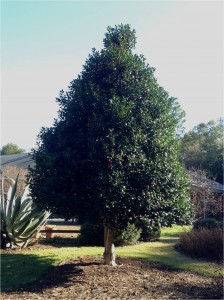
East Bay Holly. Photo by Mary Derrick, UF IFAS
[important]The best time to plant a tree was 20 years ago. The next best time is now. ~Chinese Proverb[/important]
In Florida, Arbor Day is always celebrated on the third Friday of January. In 2014, Arbor Day falls on Friday, January 17.
Consider planting a tree to enhance your property. Trees provide many benefits such as:
- Shade for leisure activities
- Lower energy costs for cooling
- Cover and food for wildlife
- Screen from unsightly views
- Privacy from neighbors
- Addition of value to your property; click here to determine the monetary value of a tree
If you have plenty of trees already, consider getting involved in a local community group that is sponsoring Arbor Day tree plantings. Or maybe your local church, park, non-profit or school would appreciate the donation and planting of a new tree.
So what trees are best to choose for the Florida panhandle? Some things to consider are soil type and pH, light, and any overhead obstructions. Click here for a publication that discusses what to consider when choosing a tree. Florida Trees for the Urban and Suburban Landscape will help you choose a particular tree species for your site. Considerations in tree selection may include bloom color and season, mature size, hurricane resistance, and whether it is evergreen or deciduous.
Once you have chosen a great tree for your specific site, proper installation and care is crucial to the success of your new tree. Click here to learn all about planting and caring for your tree.
For more information please see:
Arbor Day Foundation: Florida
Native Trees for North Florida
Palms for North Florida
Planting Trees in Landscapes
National Tree Benefit Calculator
by Sheila Dunning | Dec 17, 2013
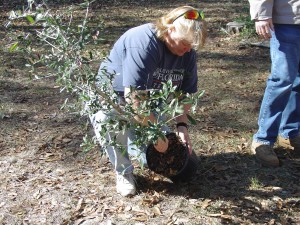
Removal of the container and inspection of the rootball is critical to tree survival.
The best time to plant a tree is twenty years ago. The second best time is Arbor Day 2014. Florida recognizes the event on the third Friday in January, so the next one is January 17, 2014.
Arbor Day is an annual observance that celebrates the role of trees in our lives and promotes tree planting and care. As a formal holiday, it was first observed on April 10, 1872 in the state of Nebraska. Today, every state and many countries join in the recognition of trees impact on people and the environment.
Trees are the longest living organisms on the planet and one of the earth’s greatest natural resources. They keep our air supply clean, reduce noise pollution, improve water quality, help prevent erosion, provide food and building materials, create shade, and help make our landscapes look beautiful. A single tree produces approximately 260 pounds of oxygen per year. That means two mature trees can supply enough oxygen annually to support a family of four.
The idea for Arbor Day in the U.S. began with Julius Sterling Morton. In 1854 he moved from Detroit to the area that is now the state of Nebraska. J. Sterling Morton was a journalist and nature lover who noticed that there were virtually no trees in Nebraska. He wrote and spoke about environmental stewardship and encouraged everyone to plant trees. Morton emphasized that trees were needed to act as windbreaks, to stabilize the soil, to provide shade, as well as, fuel and building materials for the early pioneers to prosper in the developing state.
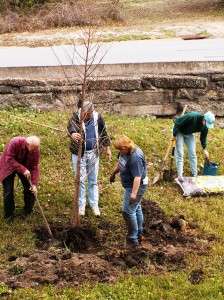
Proper planting depth and adequate watering can ensure long-term survival.
In 1872, The State Board of Agriculture accepted a resolution by J. Sterling Morton “to set aside one day to plant trees, both forest and fruit.” On April 10, 1872 one million trees were planted in Nebraska in honor of the first Arbor Day. Shortly after the 1872 observance, several other states passed legislation to observe Arbor Day. By 1920, 45 states and territories celebrated Arbor Day. Richard Nixon proclaimed the last Friday in April as National Arbor Day during his presidency in 1970.
Today, all 50 states in the U.S. have official Arbor Day, usually at a time of year that has the correct climatological conditions for planting trees. For Florida, the ideal tree planting time is January, so Florida’s Arbor Day is celebrated on the third Friday of the month. Similar events are observed throughout the world. In Israel it is the Tu B Shevat (New Year for Trees) on January 16, 2014. Germany has Tag des Baumes on April 25. Japan and Korea celebrate an entire week in April. Even, Iceland one of the treeless countries in the world observes Student’s Afforestation Day.
The trees planted on Arbor Day show a concern for future generations. The simple act of planting a tree represents a belief that the tree will grow and some day provide wood products, wildlife habitat erosion control, shelter from wind and sun, beauty, and inspiration for ourselves and our children.

Clayton ( Sheila’s grandson) will reap the benefits of the trees planted this Arbor Day.
“It is well that you should celebrate your Arbor Day thoughtfully, for within your lifetime the nation’s need of trees will become serious. We of an older generation can get along with what we have, though with growing hardship; but in your full manhood and womanhood you will want what nature once so bountifully supplied and man so thoughtlessly destroyed; and because of that want you will reproach us, not for what we have used, but for what we have wasted.”
~Theodore Roosevelt, 1907 Arbor Day Message
by Carrie Stevenson | Dec 9, 2013
How much is a 400-year old live oak tree worth? Can you buy one online, with free shipping, and charge it to the credit card? Pick one up at the local home improvement store? Ask Santa? Of course not. When admiring a tree that size, we have an innate sense of its value, but we would often have a hard time expressing it in dollars. How about a cluster of trees in a wooded lot? Are they worth more than the dollar store being built there? We are conditioned to appreciate the value of things because there’s a price tag on them. Unfortunately, natural phenomena do not have price tags, and many things that are “free” are often perceived to have no real value.
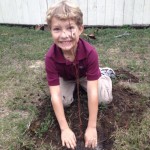
Planting a tree is an excellent way to insure clean air and water in the future. Photo credit: Carrie Stevenson
Trees, however, have value far beyond the price one might pay at a plant nursery. Their roots absorb polluted storm-water runoff, the primary cause of decreased water quality in Florida. Their leaves take in carbon dioxide and release the very oxygen we breathe. Providing homes for wildlife, fruit and nuts for human and animal consumption, compounds that form the basis of countless medications—trees provide innumerable benefits to ecosystems both local and worldwide. If a local government were to construct a facility or method that could filter the air and water at the same efficiency and volume of the trees in ones county, it would cost the community millions.
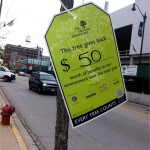
This street tree in Chicago was given a price tag to raise awareness of its value. Photo credit: Eric Stevenson
But how is is possible to capture these benefits in a way that we can relate to? Luckily, a partnership between arborists, engineers, and researchers with private industry, the US Forest Service, and the USDA has resulted in an excellent online tool called the National Tree Benefits calculator. Based on software called “i-Tree,” the calculator allows anyone to enter their zip code, choose from a list of common tree species, and using the diameter of a single tree, calculate its economic value. For example, a 15-inch live oak tree at the Escambia Extension office provides an annual benefit of $79 every year, increasing in value as it grows in girth and height. The website delves deeper into the tree’s value, placing storm-water uptake value at $23.77, electricity savings at $15.23, and the capability to remove 607 pounds of carbon dioxide from the atmosphere.
Extension Agents are currently working with youth in Escambia County to calculate these values for trees on their school campuses, local parks, and yards. When we’re finished, we will hang actual price tags on the trees showing their annual economic value to showcase these facts to residents of the community.
Interested in what kind of economic benefit that magnolia in the front yard is giving you? Check it out yourself at www.treebenefits.com, and let your neighbors know how valuable those trees can really be.
by | Jan 16, 2013
As mentioned in the article written by Carrie Stevenson last week, we celebrate Arbor Day here in Florida on January 18th this year. It’s a day we specifically set aside to celebrate and appreciate the role living trees play in improving our lives and our environment. With that in mind, many people plant trees to celebrate the occasion and this time of the year is, without a doubt, the perfect time to plant additions to our landscape and what could be better than selecting a tree that actually flowers in the spring to add some panache.
One of the best reasons for choosing a flowering tree is they will add so much color and beauty to our landscapes over the next few months. Throughout this article I am going to mention some of my favorite trees that do very well in this area and list some of the reasons I find those listed here remarkable. Do understand though, this is not a complete list of all the flowering trees, just several that I personally find remarkable and worth mentioning. A University of Florida EDIS publication written by Dr. Gary Knox that can be found here lists many more flowering trees that do well here in North Florida. In addition there is a book, The Southern Gardener’s Book of Lists, written by Lois Trigg Chaplin which includes many more that will do very well in this area.
One of my personal favorites is the Red Maple. At 40 feet tall, this is one of the largest of the spring-flowering trees (Acer rubrum), and it is coming into bloom right about now.

The Red Maple is a Fantastic Choice for North Florida Landscapes
This tree species separates the sexes into individual plants, so there are male red maple trees and female red maple trees. It is the females that put on the more attractive display in the spring. Not only are their flowers more showy, but those flowers turn into attractive fruit. You may notice these trees in your area – with their deep-red, burgundy or rusty-red, boomerang-shaped fruit clustered all along their leafless branches.
The red maple also makes an excellent shade tree. Although it can grow in wet areas, it adapts readily to well-drained urban landscapes. It is a deciduous tree with an upright oval shape and a moderate to fast rate of growth.
Another choice, the Taiwan flowering cherry (Prunus campanulata), produces deep pink in great abundance before the leaves emerge. Flowering generally begins in mid- to late January and extends over two to three weeks. This is one of the few flowering cherries that grows and blooms reliably this far south. It prefers to grow in a sunny to partly sunny location with excellent drainage.
The ‘Okame’ flowering cherry is another type that will grow successfully in North Florida. Pale pink flowers are produced in March or April.
The Oriental magnolia (Magnolia x soulangiana) is one of the most spectacular of the spring-flowering trees because its flowers are so large. Unlike the evergreen Southern magnolia, the Oriental magnolia is deciduous and loses its leaves in winter. Appearing in January and February before the foliage comes back, the fragrant flowers are tulip-shaped, 4 inches to 6 inches across and may be flushed pale pink to purple on the outside and white on the inside. Long-lived and reliable, Oriental magnolias grow 15 feet to 20 feet tall and need a sunny location with good drainage.
The related star magnolia (Magnolia stellata) is smaller, growing 10 feet to 12 feet tall, and is more shrub-like. Its white or pale pink flowers are star-shaped and wonderfully fragrant. Blooming in late January or February before the foliage reappears, the star magnolia is an excellent choice for small space gardens.
The native silver bell (Halesia diptera) is a lovely tree that is often recommended as a substitute for dogwoods and is less fussy about its growing conditions. The trees do not really resemble each other that closely, but the silver bell does bloom at about the same time with small, four-petal, white flowers that hang down in large numbers from the branches. The thin leaves allow light to filter through, creating a lovely effect under the tree. They grow well with light shade or in full sun and mature at about 25 feet to 30 feet.
The hawthorns are a wonderful group of native trees that provide spring bloom as well as fruit for human or wildlife consumption. One of my favorites is the parsley hawthorn (Crataegus marshallii). Growing 15 feet to 20 feet tall, it is an excellent choice in patio or small space plantings. The clusters of white flowers appear in March or April and are soon followed by the foliage, which looks like flat Italian parsley, hence the tree’s name. The small red fruit that ripen in fall are relished by mocking birds. Parsley hawthorn is tolerant of poorly drained soils and grows in full sun to part shade. When the trees are young they possess thorns.
Fringe tree (Chionanthus virginicus) is a delightful native tree that thrives in well-drained locations with full sun to partial shade. The flowers are greenish white and are produced in masses all along the branches. The narrow petals and hanging habit give the flowers a fringe or beard-like appearance. In the wild you usually see them growing on the edge of the woods. The Chinese fringe tree (Chionanthus retusus) also grows well here and is even showier than our native species.
Another excellent spring-flowering tree is the redbud (Cercis canadensis), which usually blooms in late February or March. Small, pinkish-purple, pea-like flowers are produced in unbelievable profusion along the branches (and even on the trunk!) before the leaves appear. This habit of blooming before the leaves grow out is fairly common among the spring-flowering trees and really adds to the impact of the flowers. Redbuds are relatively fast growing once established and prefer full sun and a well-drained location







